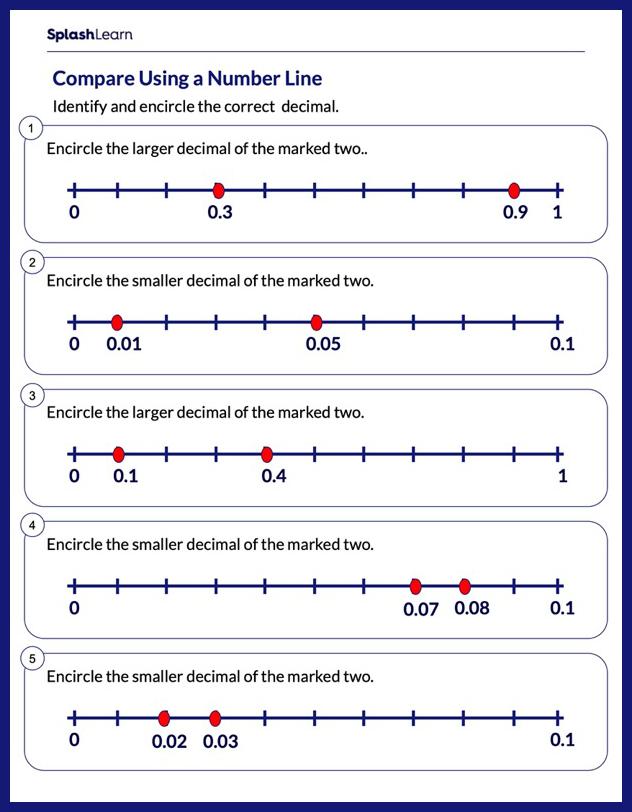What are Comparing and Ordering Numbers?
Have you ever compared your height and your friend’s height to decide who is taller? Or has the teacher ever asked your class to stand in increasing order of height?
This type of situation can be answered by comparing and ordering numbers. “Comparing” in math is the process in which we observe similar properties of different persons or objects or things. Ordering a list of numbers means stating the numbers from the least to the greatest or from the greatest to the least. Before we learn how to compare and order numbers, let us first introduce the meaning of comparing numbers.
Recommended Games
Comparing Numbers Meaning
Comparing in math refers to viewing something in relation to another. So, what is comparing numbers? Comparing numbers in math is defined as a process or method in which one can determine whether a number is smaller, greater, or equal to another number according to its values.
The definition of comparison in math is all about identifying a quantity greater, smaller, or equal in relation with the given number.
Recommended Worksheets
Symbols for Comparing Numbers
The symbols used for comparing numbers are $\gt,\; \lt,$ or $=$.
- $“\gt”$ means “greater than”
- $“\lt”$ means “less than”
- $“=”$ means “equal to”

We also use the following symbols for comparing two quantities.
means “less than or equal to”
means “greater than or equal to”
Example: Let’s understand this visually using vertical bars composed of blocks. Each small block is of the same size. We can compare the numbers by comparing the heights of the bars.
On comparing two numbers, we can find out by how much a number is greater or smaller.
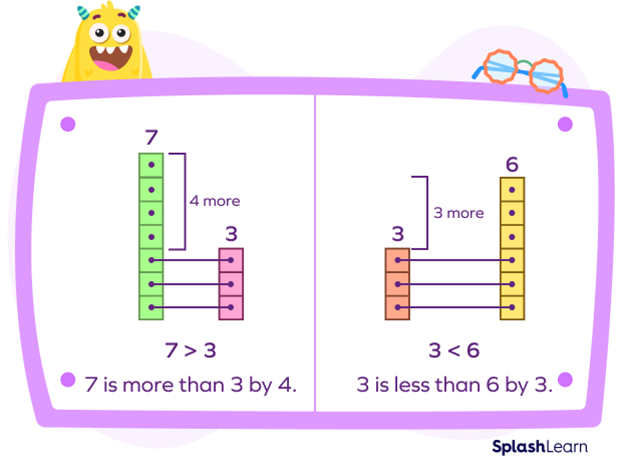
- In the first example, $7 \gt 3$ since the green bar is taller than the pink bar.
We can also say that 7 is more or greater than 3 by $7 \;−\; 3 = 4$.
- In the second part, $3 \lt 6$ since the red bar is shorter than the yellow bar.
We can also say that 3 is less or smaller than 6 by $6 \;−\; 3 = 3$.
Steps for Comparing Numbers
Step 1: Compare the number of digits. The number with the more digits, is greater. Note that 0 placed at the beginning of a number is insignificant.
Example: $358 \lt 9104$
Step 2: If the number of digits are the same, we start by comparing the highest place values.
Example: In the following example, $312521 \lt 312712$ since $5 \lt 7$ at the hundreds place.
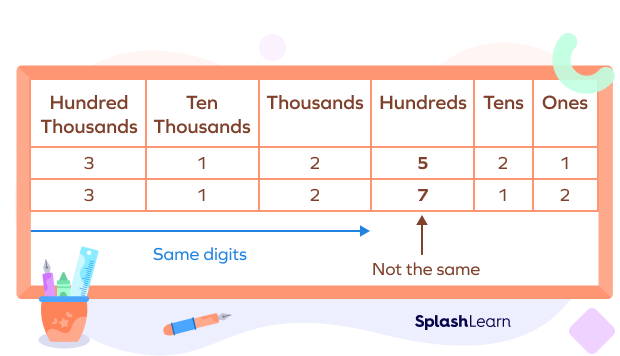
What Is Ordering Numbers?
Ordering a list of numbers means arranging the numbers from least to greatest or greatest to least. In other words, we can say that ordering numbers means arranging numbers either in increasing order or decreasing order.
- Ascending order
Arrangement of numbers in increasing order, from the smallest to the greatest, is called ascending order.
For example $2 \lt 4 \lt 6 \lt 8 \lt 10$
- Descending order
Arrangement of numbers in decreasing order, from the greatest to smallest, is called descending order.
For example, $10 \gt 8 \gt 6 \gt 4 \gt 2$
Comparing and Ordering Real Numbers Using a Number Line
On a number line, the numbers increase as we go from left to right. Thus, the number on the right is always greater than the number on the left. Thus, any two real numbers can be compared based on their position on the number line.
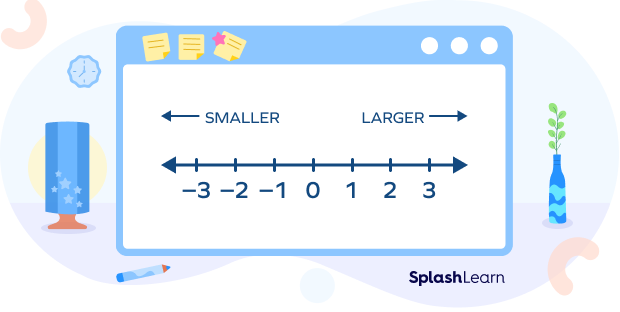
Example: Compare –9 and 8 on the number line.
-9 lies on the left side of 8.
Thus, -9 < 8.
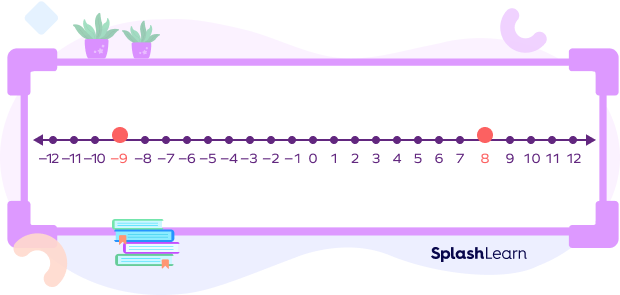
We can order the integers in increasing order as shown below
$…\; \lt -9 \lt -8 \lt -7 \lt -6 \lt …\lt -2 \lt -1 \lt 0 \lt 1 \lt 2 \lt 3 \lt 4 \lt …$
Similarly, $0.5 \lt 1.4$ since 0.5 lies on the left side of 1.4.
Comparing Rational Numbers
Comparing two or more rational numbers is similar to comparing fractions. We just need to keep in mind that:
- All negative rational numbers are smaller than 0.
- All positive rational numbers are greater than 0.
- All positive rational numbers are greater than all negative rational numbers.
As we know that rational numbers include whole numbers, integers, fractional, and decimal numbers in it, hence comparing two or more rational numbers can be categorized as
- Comparing Whole Numbers
- Comparing Integers
- Comparing Fractions
- Comparing Decimals
Let’s discuss steps for comparing numbers for each category one by one.
Comparing Whole Numbers
There are some steps through which we can compare two or more whole numbers:
Step 1: We should compare the number of digits. If there are more digits, it means the number is greater. For example $15 \gt 9,\; 125 \gt 32$, etc.
Step 2: If the number of digits is the same in both numbers, then we should compare the highest place values or the digit to the extreme left of the numbers. For example, $65 \gt 57,\; 243 \gt 127$, etc.
Step 3: If the digits at the highest place value are the same, we should compare the digits in the next digits to the right or the second highest place value. For example $76 \gt 72,\; 358 \gt 348$, etc.
Step 4: We keep comparing digits with the same place value until we find digits that are different. The number with the greater face value is the greater number. $109 \gt 102,\; 557 \gt 552$ etc.
Comparing Integers
- Comparing two positive integers is the same as comparing whole numbers except comparing with a negative integer.
- A positive integer is always greater or more than a negative integer.
For example $5 \gt \;−\;5,\; 80 \gt \;−\; 80$, etc.
- For comparing two negative numbers, we say that the greater number with a negative sign is the smallest of two negative integers.
For example $−\;80 \lt \;−\;75,\; −\;15 \lt \;−\;5$, etc.
- Negative integers are less than 0 and positive integers are greater than 0.
For example $−\;5 \lt 0, \;−\;12 \lt 0,\; 8 \gt 0$, etc.
Comparing Fractions
When two or more fractions share the same denominator, the fractions are called “like fractions.” When two or more fractions have different denominators, they are called “unlike fractions.”
Comparing Like Fractions
To compare two or more like fractions, we just have to compare the numerators.
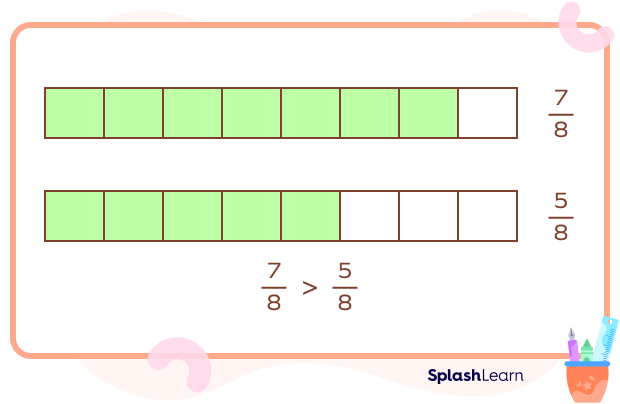
In the above figure, since $7 \gt 5$, hence $78\gt58$.
Comparing Unlike Fractions
To compare two or more unlike fractions, we can use different methods.
- Cross Multiplication Method
We multiply the numerator of the first fraction by the denominator of the second fraction and write the answer.
For example, we have to compare $\frac{5}{8}$ and $\frac{6}{11}$.
So, we multiply 5 and 11 together and 8 and 6 together, and we get
$5 \times 11 = 55$ and $6 \times 8 = 48$
After that, we can compare them like two whole numbers.
$55 \gt 48$
Finally, we replace the numbers with fractions.
$\frac{5}{8} \gt \frac{6}{11}$
- Making the Denominators the Same
In this method, we first find the LCM of both denominators.
Let us take the above example, i.e., compare $\frac{5}{8}$ and $\frac{6}{11}$.
LCM $(8,\; 11) = 88$
To make the denominator the same, multiply the numerator and denominator by a relevant number.
$\frac{5 \times 11}{8 \times 11} = \frac{55}{88}$ and $\frac{6\times8}{11\times8} = \frac{48}{88}$
After the denominators become the same, we compare the numerator.
$55 > 48$
Finally, we replace the numbers with fractions.
$\frac{55}{88} \gt \frac{48}{88} \Rightarrow \frac{5}{8}\gt\frac{6}{11}$
Comparing Decimals
We can compare two or more decimals by using the following steps:
Step 1: Firstly, compare the whole number part (i.e., compare the digits before the decimal). If they are different, you can compare the numbers as you would for any whole number. If they are the same, then follow the next step.
Step 2: Compare the tenth place. If they are different, then compare the numbers as you would for whole numbers. If they match, then move on to the next digit.
Step 3: Compare the hundredths place. If they are different, then compare those digits as you would for whole numbers. If they match, then move on to the next digit.
Example: Compare 23.56 and 23.289.
The numbers before the decimal are the same. So, we move to the next step, i.e., comparing the tenth place. Since $5 \gt 3,\; 23.56 \gt 23.289$.
Fun Facts!
- All negative rational numbers are smaller than 0.
- All positive rational numbers are greater than 0.
- All positive rational numbers are greater than all negative rational numbers.
Conclusion
In this article, we have discussed the meaning and symbols of comparing numbers, the method of comparing numbers, ordering, ascending and descending order as well as some important facts, and problems based on comparing and ordering numbers.
Solved Examples On Comparing and Ordering
- Compare the numbers 425 and 412.
Solution:
Given numbers 425 and 412.
Since the number of digits is the same in both numbers and the first digit is also the same, i.e., 4. But the digit at tens places 2 > 1.
Therefore, $425 \gt 412$
Hence, 425 is greater than 412.
- Which number is smaller out of $−612$ and $−625$?
Solution:
For comparing two negative numbers, we say that the greater number with a negative sign is the smallest of two negative integers.
Therefore, $−625 \lt −612$
Hence, $−625$ is smaller than $−612$.
- Compare $\frac{3}{5}$ and $\frac{5}{9}$.
Solution:
We have to compare $\frac{3}{5}$ and $\frac{5}{9}$.
Using the cross multiplication method,
$\frac{3}{5} = \frac{3 \times 9}{5 \times 9} = \frac{27}{45}$
$\frac{5}{9} = \frac{5 \times 5}{9 \times 5} = \frac{25}{45}$
Here, $27 \gt 25$
So, $\frac{27}{45} \gt \frac{25}{45}$
Finally, we replace the numbers with fractions $\frac{3}{5} \gt \frac{5}{9}$.
- Compare the numbers 5, 0, 10, and $−15$. Also, arrange them in ascending order.
Solution:
Given a list of numbers $5, 0, 10,$ and $−15$.
Since a positive integer is always greater than a negative integer, $−15$ is smaller than all of the given numbers.
Also, negative integers are less than 0 and positive integers are greater than 0.
Hence, $−15 \lt 0 \lt 5 \lt 10$ (ascending order).
- Which is greater: 3.025 or 3.003?
Since the ones and tenth place of both the numbers are the same. So, we will see the hundredth place. Since $2 \gt 0$.
Hence, $3.025 \gt 3.003$.
Practice Problems On Comparing and Ordering
Comparing and Ordering Numbers: Definition with Examples
Which of the following is not a sign of comparing two numbers?
The sign given in option d $(\Rightarrow)$ is of implies a symbol, which is not used for comparing two numbers.
Which of the following is greater than $−5$?
$0$ is greater than all negative numbers.
On a number line, $−4$ and $−1$ lie on the left side of the $−5$.
Hence all numbers, i.e., $−4,\; −1$, and $0$ are greater than $−5$.
Choose the correct sign for blank space: $\frac{13}{19}$ ——— $\frac{17}{19}$.
Since both the fractions have the same denominator and $13 \lt 17$,
$\frac{13}{19} \lt \frac{17}{19}$
Ordering of a list of numbers in increasing order is called _________ order.
Ordering of a list of numbers in increasing order is called ascending order.
Frequently Asked Questions On Comparing and Ordering
Why is comparing numbers important in our daily lives?
We compare numbers in our daily lives. For example, for comparing weights, for comparing the prices of everyday items, comparing the height of two or more people, etc.
How is comparing numbers different from ordering numbers?
Comparing numbers is a method of identifying greater, smaller, or equal numbers. Ordering numbers means arranging them in an ascending or descending order.
What is a quick way of comparing numbers?
The easiest way to compare numbers is by marking the numbers on a number line.
What are the different ways to compare numbers?
We can use different approaches to compare numbers, such as comparing numbers on a number line, by counting the number of digits, using place values of the numbers, etc.


























